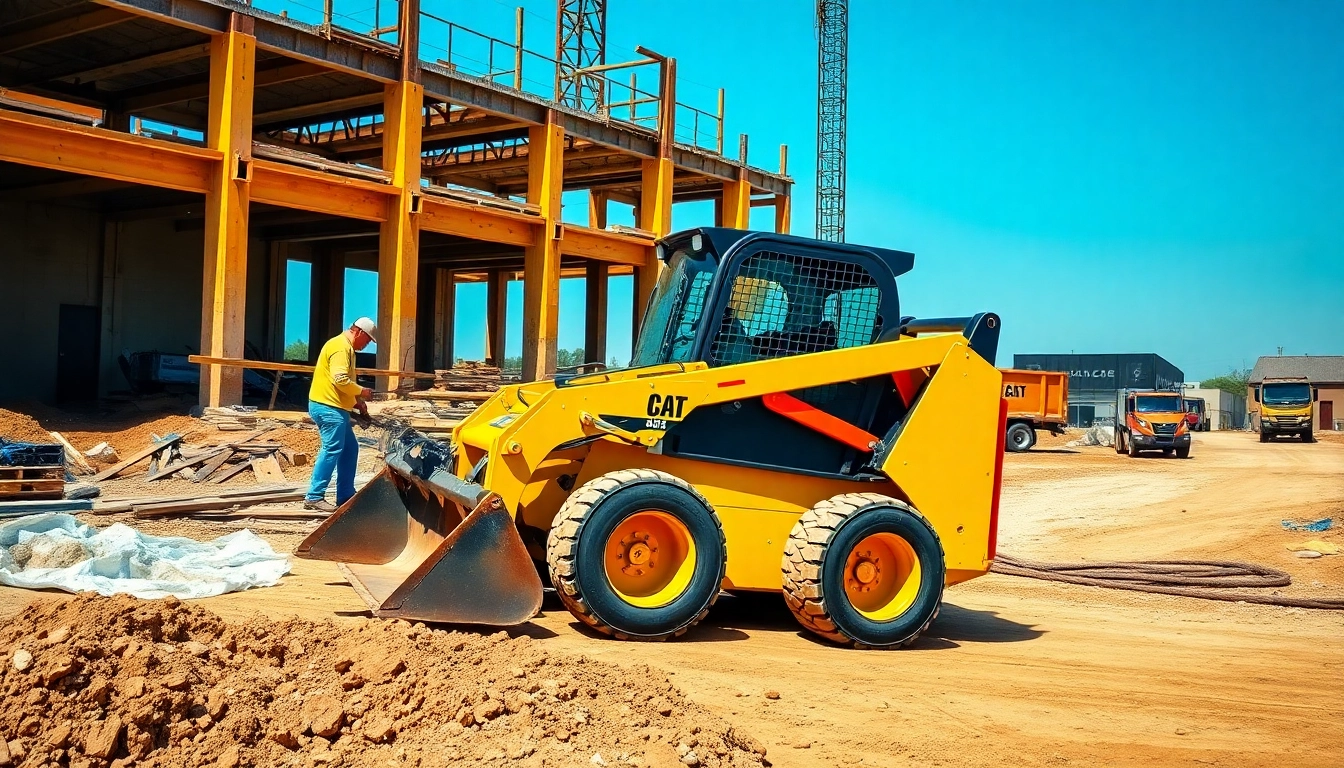Understanding Skid Steer Loans
Investing in a skid steer is a substantial financial commitment, often requiring sound financing options to make acquisition feasible. A Skid Steer Loan can unlock the potential to enhance your operational capabilities, facilitating the purchase of this invaluable piece of equipment. Understanding how skid steer loans work can help you leverage these financing options effectively, ensuring that you make a choice that aligns with your financial goals.
What is a Skid Steer Loan?
A skid steer loan is a type of equipment financing specifically tailored for purchasing skid steer loaders. These compact machines, characterized by their unique steering capabilities and versatile attachments, are indispensable in a variety of construction, landscaping, and agricultural applications. Skid steer loans allow you to borrow funds needed to purchase the equipment while spreading the cost over time, typically through manageable monthly payments. This financing solution enables businesses and individuals to acquire heavy machinery without the immediate financial burden of a full one-time payment.
Benefits of Financing a Skid Steer
Financing a skid steer offers several advantages:
- Improved Cash Flow: Rather than depleting your cash reserves, financing allows you to allocate funds towards other critical business operations.
- Manageable Payments: Structured payment plans make it easier to budget and manage cash flow effectively.
- Access to Advanced Equipment: Financing enables you to acquire the latest technology and models, which can improve operational efficiency and effectiveness.
- Tax Benefits: Depending on your jurisdiction and the nature of your business, the interest paid on skid steer loans may be tax-deductible.
- Builds Credit: Timely loan repayments can enhance your credit profile, which can be beneficial for future financing needs.
Types of Skid Steer Loans Available
There are several types of skid steer financing options available, each catering to different needs and circumstances:
- Secured Loans: These loans are backed by collateral (typically the skid steer itself), which can lead to lower interest rates and more favorable terms.
- Unsecured Loans: These loans do not require collateral, making them a viable option for those without substantial assets, although they often come with higher interest rates.
- Leasing: An alternative to traditional loans, leasing provides access to a skid steer for a fixed term with the option to purchase at the end. This is particularly advantageous for businesses that need equipment but may not have the capital to buy outright.
- Lines of Credit: Businesses can utilize a line of credit to manage their cash flow while making ongoing skid steer purchases as needed.
How to Qualify for a Skid Steer Loan
Key Eligibility Criteria
Qualifying for a skid steer loan typically involves a few key eligibility criteria that lenders evaluate:
- Credit Score: A credit score of around 640 is often needed to qualify for most equipment financing solutions. However, some lenders may work with lower scores.
- Business Longevity: Established businesses often have an advantage; newer businesses might need to provide additional documentation or personal guarantees.
- Cash Flow: Lenders will want to ensure that you have the cash flow necessary to manage the monthly payments. This often requires submitting financial statements or bank statements for review.
Documentation Needed for Application
When applying for a skid steer loan, you will typically need to gather and submit various documents:
- Financial Statements: Include profit and loss statements, balance sheets, and tax returns for the past few years.
- Personal Financial Documents: If you are a sole proprietor or a new business, be prepared to submit personal financial documents that reflect your individual creditworthiness and financial situation.
- Business Plan: For new businesses, a robust business plan can help demonstrate your ability to generate revenue and manage debt responsibly.
Common Mistakes to Avoid
Avoiding common pitfalls during the loan application process can save you time and stress:
- Neglecting Research: Failing to compare loan offers and interest rates can lead to missed opportunities for better financing terms.
- Inaccurate Financial Reporting: Providing inaccurate or insufficient financial data can hamper your chances of approval.
- Overextending Financially: Calculating affordability against your current cash flow is crucial to preventing potential financial strain.
Choosing the Right Lender for Your Skid Steer Loan
Comparing Loan Offers and Rates
When looking for a lender, it’s essential to compare multiple loan offers carefully. Consider the following factors:
- Interest Rates: Look for competitive rates that suit your financial situation. Even a small difference can significantly affect the total cost over the loan term.
- Loan Terms: Analyze the length of the loan, prepayment penalties, and borrower protections.
- Customer Service: Research lender reviews to see how they treat their customers. A lender with responsive support systems can help you during challenging situations.
Questions to Ask Potential Lenders
Asking the right questions can help clarify the terms of the loan and ensure you’re making the best choice:
- What are the total costs associated with this loan, including fees?
- Are there penalties for early repayment?
- What is the process for managing cash flow issues if they arise?
- Can the loan be adjusted based on changing business needs?
The Role of Credit Scores in Financing
Your credit score plays a crucial role in determining your eligibility for a skid steer loan. A higher credit score generally leads to more favorable terms, such as lower interest rates and better loan conditions. Understanding how your credit score is calculated, and improving it when possible, can provide better financing opportunities. Strategies to improve your score include timely bill payments, reducing outstanding debts, and reviewing your credit report for errors.
Application Process for a Skid Steer Loan
Step-by-Step Guide to Applying
The process to apply for a skid steer loan typically involves several steps:
- Identify Your Needs: Assess your equipment requirements, including the type and specifications of the skid steer you need.
- Research Lenders: Explore various lenders and assess their loan offerings, interest rates, and requirements.
- Prepare Documentation: Collect the necessary documentation, such as financial statements, tax returns, and business plans.
- Submit Applications: Apply to multiple lenders to better your chances and compare offers.
- Review Loan Documents: Carefully read through the loan terms and ensure they align with your expectations.
- Finalize Loan: Once you’ve chosen a lender, follow through with the necessary steps to finalize your loan agreement.
Understanding the Timeline for Approval
The timeline for approval can vary significantly based on the lender, your financial situation, and the complexity of your application. Typical timelines may range from a few hours to several days. Working with experienced lenders can expedite the process, as they often have procedures in place to streamline approval and funding.
Post-Approval: What to Expect
After your loan is approved, you will receive the terms of the loan and details on funding disbursement. Be prepared to review and sign a loan agreement outlining all conditions. Once funded, you can proceed to purchase your skid steer. Ensure you keep track of your payment schedule as well as any deadlines for required documentation or conditions from the lender.
Managing Your Skid Steer Loan Effectively
Strategies for Repayment
To manage your skid steer loan effectively, develop a clear repayment strategy. Here are some tactics to consider:
- Create a Budget: Ensure that monthly payments are accounted for in your overall financial planning.
- Consider Automatic Payments: Setting up automatic payments can prevent missed payments and help you avoid late fees.
- Monitor Your Cash Flow: Regularly analyze your income and expenses to ensure that you’re on track to meet your obligations.
Refinancing Options to Consider
As your business grows and financial circumstances change, you may want to consider refinancing your skid steer loan. This could potentially lower your monthly payments or reduce interest rates. When exploring refinancing options, consider the terms of your current loan and what new lenders can offer. It’s essential to account for fees associated with refinancing to ensure that the new terms genuinely provide financial benefits.
Staying Informed on Market Trends
Keeping an eye on equipment financing trends can help you make informed decisions about your skid steer loan. Market changes may influence interest rates, lending criteria, or even the availability of new financing products. Following reputable financial news sources and industry publications can provide valuable insights into the best times to borrow or refinance.






